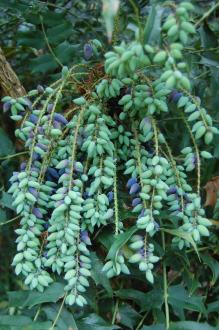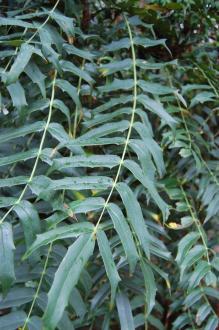
Mahonia lomariifolia Berries (05/05/2012, kew Gardens, London)
Position: Partial shade to full shade
Flowering period: Winter
Soil: Moist, well drained
Eventual Height: 3m
Eventual Spread: 2m
Hardiness: 8a – 10b
Family: Berberidaceae
Mahonia lomariifolia is a slow growing medium/ large upright, evergreen shrub. Its dark green glossy leaves are odd pinnate, up to 60cm long, composed of up to 20 pairs of spiny leaflets. The newly emerging leaves are red in color. Its bark is fissured. Its yellow fragrant flowers are borne in clusters of up to 20 upright racemose at the tips of the branches, each racemose being up to 25cm long. Its fruit appear green and mature to a blue/ black.

Mahonia lomariifolia (05/05/2012, kew Gardens, London)
Mahonia lomariifolia, commonly known as the Chines Holly Grape, is native to southeast China and Burma.
The etymological root of the binomial name Mahonia was named by Thomas Nuttall after an Irish political refugee, Bernard M’Mahon. Lomariifolia refers to the folium (meaning ‘leaf’ in Latin) being similar to the Lomaria genus.
The landscape architect may find Mahonia lomariifolia useful as an upright barrier plant, particularly for shady locations. Care should be taken when locating this plant due to its sharp leaves.
Ecologically, Mahonia lomariifolia is attractive to pollinating insects. The berries are attractive to birds.

Mahonia lomariifolia Leaf (05/05/2012, kew Gardens, London)
The Royal Horticultural Society has given Mahonia lomariifolia their prestigious Award of Garden Merit in 1993.
Mahonia lomariifolia prefers moist, humus rich, well-drained soils. It tolerates most pH of soil.
Mahonia lomariifolia requires little maintenance. If necessary, pruning should be carried out in late winter.

